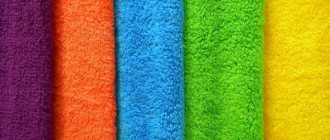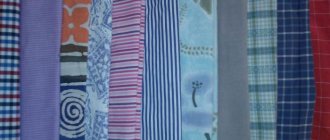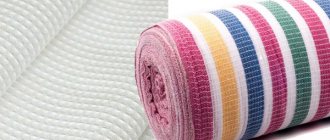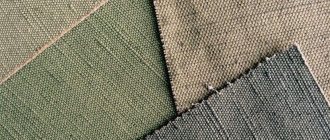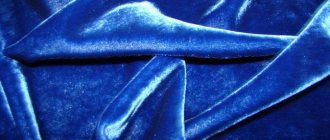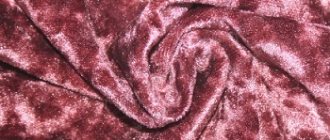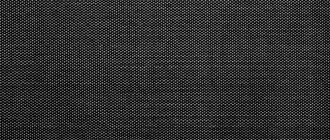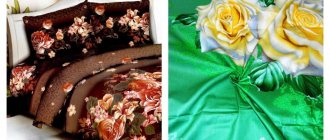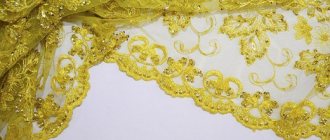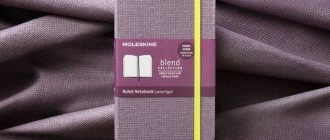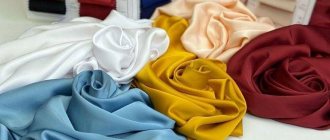Terry or terry cloth is well known to consumers. This is a natural material, its entire surface is covered with an even layer of tiny loops that form a fluffy terry layer. The fabric is pleasant to the touch, does not irritate the skin and perfectly absorbs moisture. It paints well in any color, and the paint coating is durable. The material is used in the clothing industry to produce clothing items and household accessories. A quality product uses only natural fiber.
Terry fabric - what is it?
Terry or terry cloth is a material whose surface is covered with loops. They can be located on one or both sides. It is very pleasant to the touch, soft, and fluffy in appearance. The official name of the material is “frote”, derived from the French verb “to rub”. There is a clear connection with the purpose of towels, which are most often made from terry.
Important! The starching solution is made from just two ingredients - water and starch. In general, potato, corn or rice starch is used, but the last two do not give a very good lasting result. But potato is perfect. This solution is absorbed very well into the fabric and after ironing creates a protective layer on it.
What standards are used in production?
Fabric production is regulated by a number of GOSTs:
- GOST 3812-72 prescribes methods for determining the density of threads and pile bundles.
- GOST 3816-81 (ISO 811-81) establishes methods for determining hygroscopic and water-repellent properties.
- GOST 9733.0-83 defines general requirements for testing methods for color fastness to physical and chemical influences.
- GOST 15.007 talks about compliance with approved standard samples and permissible deviations in the surface density of fabrics, which for terry fabrics and products should not exceed minus 10%;
History of origin and popularization of fabric
There are several versions of the appearance of frote. According to one of them, India is considered the homeland. Another theory says that matter first appeared in Turkey. This is confirmed by the external resemblance of the material to carpet. But carpets were woven in India, Pakistan, and Uzbekistan. It would be correct to say that the birthplace of cotton is also the birthplace of terry, since it is from natural cotton that this looped fabric is made. The product took on a more modern and familiar appearance in the 18th century, when textile factories producing cotton fabric appeared. The massive demand for fabrics created the need for large quantities of raw materials.
Looped terry
Cotton began to be sown in the southern regions of the Russian Empire, Egypt, China, and the USA. In Russia, cotton gradually pushed linen into second place. The technology for producing terry fabric was not a state secret, like silk. Many countries around the world have successfully used it. The fluffy soft material has become universally popular.
As in many areas, there is innovation in the textile industry - terry fabric made from bamboo fibers is gaining popularity. The raw material grows in tropical and subtropical climates, and crushed stems and leaves are used to make fibers.
Bamboo terry
Compound
Initially, the composition of the material described was only cotton. Let us remember that terry appeared for the first time in India, a country that has long been famous for its cotton fabrics. Until now, cotton terry is considered one of the best, as it has excellent hygroscopic properties and comfort in use.
However, raw materials are not an indicator at all. Today, cotton is added to many fabrics. And if materials such as satin or calico were originally made from plant materials, then such fibers are not at all characteristic of jacquard or satin. But, nevertheless, they are added to give greater wear resistance, improve characteristics and reduce the cost of textiles. So what distinguishes terry from other materials?
It is worth mentioning the special terry weave, with the help of which unique fabrics are created. This fabric cannot be called pile fabric, since the method of obtaining the characteristic surface is different. Hairs are obtained due to the fact that the warp loops are fed more freely. They seem to stretch upward or in both directions. This is how a surface resembling a pile is obtained. Sometimes manufacturers decorate the fabric with intricate patterns of loops, making only certain areas terry.
Terry is often called knitted, which is actually incorrect, because this material is traditionally woven, not knitted. Modern production allows the manufacture of frote from flax or bamboo. Sometimes synthetic, artificial fibers are added to the composition, but in minimal quantities. The best option is classic 100% cotton.
The density of the finished fabric is high, but lower than that of real pile textiles: from 300 g/m2 to 500 g/m2.
Production process and raw materials
Cotton, linen or bamboo are used as raw materials for the production of frote material. To impart wear resistance, synthetic fibers are introduced into the composition, but their share should not exceed 20% of the natural base. Loops of pile can be pulled out from the main thread, and can also be formed with an additional thread, often of a different color. Decoration on products is done by using synthetic threads, changing the length of the pile, partially cutting and cutting the loops, releasing fringes and placing the loops at a different angle.
You might be interested in Description of the veil, features of the fabric and use of the material for sewing curtains
Important! The most expensive is bamboo terry fabric, made from cellulose fibers. The products are soft and silky.
The base of terry fabric can also be knitted, then the product will be elastic.
Knitted terry
What can it be used for?
If you are interested in what can be sewn from terry fabric, then you have many options. We have already mentioned regular towels, which can be sewn to any scale.
You can also make a robe that can be single sided or double sided. You will receive a very soft and pleasant product.
Bed linen will also please you for a long time. You will feel warm and comfortable sleeping on it, especially during the cold season.
Let's talk about what mixed fabric means in another review.
Main characteristics
The main characteristics of the material are the following indicators:
- The degree of twist of the thread - the more twisted the thread, the higher the quality indicator of the fabric.
- Density - indicators can be completely different, their range is from 250 to 800 g/m2. Low-density fabric (250-300 g/m2) is usually thin and light; it is made with a high synthetic content. The average density (350-500 g/m2) of the most popular and widely used variety of terry. It absorbs water well and is easy to use. High-density fabric (above 550 g/m2) is very heavy, bulky, and quite expensive. Density determines the degree of fluffiness, since the weight of the fabric per square meter depends on the number of loops.
- Pile height is also an important indicator of fluffiness. A short pile will be hard and rough, while a long pile will give the fabric softness. The optimal pile size is 5 mm.
An important characteristic of the material is its ability to absorb moisture. High density, long and well-twisted pile increase this ability, but give it a lot of weight.
Pile on terry cloth
Varieties
Historically, a great variety of types of terry cloth have been formed, and besides, technologists develop new ones almost every year.
The main indicators by which it is classified:
- density;
- pile height;
- twisting of threads.
To improve the absorbency of the material, the raw material - that is, cotton threads - is additionally twisted, and a thick thread is twisted from several thin ones. The finished product is a little rougher, but it performs its functions at the highest level.
The best towel fabric is with the thickest pile, double-sided, with a tight twist of the threads.
Not long ago, terry-waterproof terry appeared: a one-sided material to which a synthetic (PA or PVC) membrane is glued on the backside. The material is considered a godsend for the furniture industry.
Types of terry cloth
There are several types of loop fabric that differ in appearance. But their main differences are in the production method and composition.
- Brushed - soft and warm knitted material with combing on the reverse side.
- Looped - fabric with uncut solid threads; It has high density and softness; with the addition of bamboo fiber, the fabric acquires antiseptic properties.
- Torn is a soft fabric with long pile, which contains polyester threads, the material is wash-resistant. Fabric that contains only artificial fibers is also called velsoft.
- Terry with a membrane is a combined fabric, which on one side (the front) has a cotton pile base, and on the other side there is a waterproof polyurethane membrane. This fabric does not require ironing.
Membrane material
- Double-sided woven is a thicker fabric compared to single-sided terry, which has loops on both the front and back sides.
- Terry fleece is a type of fleece with short loops. The composition contains both natural fibers, usually cotton, and polyester threads. The fabric retains heat and is breathable at the same time.
You might be interested in the components of stripe satin: areas of application of the fabric
Fleece terry
- Jacquard is a fabric with a pattern that is woven into the base rather than applied by dyeing.
Thank you!
Your application has been sent. A manager will contact you shortly to clarify details.
Request a call
- Elegant
- Blouses and dresses
- Jacquard
- Costumes
- Lace
- Mix
- Organza
- Coats
- Knitwear
- Accessories
- Cotton
- Sale
How to choose a good terry
You need to choose a product according to three main criteria:
- Fabric composition - ideally there should be only natural material (linen, cotton or bamboo), in extreme cases the proportion of synthetic fiber should not exceed 20%. Chinese manufacturers often sin by adding a higher percentage of synthetics, since cotton does not grow in China, it is exported. It is better to choose terry fabric from Russian and Turkish companies. Uzbekistan and Turkmenistan, where cotton grows, are also famous for their quality goods.
- The density of high-quality fabric should not be low, otherwise the fabric itself will be “loose”. On average, 350-400 g/m2 will be enough. Higher density fabric will be too heavy and uncomfortable.
- The length of the loops of the pile should be 5 mm, there should be no strongly twisted piles. This also makes the fabric heavy and rough.
All information on composition and density must be indicated on the product label or packaging. Also, the product itself must be touched with your hands, “felt”, in order to evaluate the tactile sensations.
Description of material
The main raw material for fabric production is cotton; products made from flax or bamboo are less common. 100% natural terry has the best characteristics. The use of synthetic substances (polyester, polyamide) is allowed within 20%. Higher contents can cause allergic reactions, rapid wear of products and deterioration in their quality. Synthetics are not always added in order to reduce production costs - artificial materials increase the elasticity of the fabric.
Unlike pile materials, frote has a lower density and loose structure. This is due to the manufacturing technology - the loops are part of the base of the fabric, and are not woven separately. As a result, hygroscopicity increases significantly - the fabric perfectly absorbs moisture, which makes it possible to make bath accessories from it.
All-natural terry fabric wrinkles easily, but under the pile it is almost invisible. It provides good air exchange and thermoregulation, retaining all its properties even after frequent washing.
Application area
The main direction in the use of terry is the production of bathing and bathing accessories - towels and sheets, bathrobes, hats, bath pareos, slippers and massage mittens.
Important! Bed linen and mattress covers, children's clothing and goods for children, and clothing for the home are popular.
Towels
Towels are made in different sizes, depending on their purpose. Bath towels, hand and foot towels, kitchen towels. Fabric for terry towels is used both single-sided and double-sided. The latter provides better absorbency and increases the volume of the product. There are a wide variety of colors and patterns on towels.
Terry towels
Robes
Robes with all kinds of embroidery are sewn from double-sided or torn terry. The products are lightweight and can be worn for a long time without deformation.
Bathrobe
Bed sheets
The advantage of linen made from forte fabric is that it is durable, pleasant to the body, and has a massage effect. The fabric used is double-sided or single-sided looped. Membrane terry is ideal for mattress covers. It will protect the mattress from moisture and preserve its orthopedic properties longer.
You might be interested in Features of using felt fabric in needlework and creativity
Bed sheets
Orthopedics
Special mattresses and orthopedic pillows, as well as orthopedic insoles are made from terry. They do not cause allergies, retain heat and allow the skin to breathe.
Insoles for shoes
Products for children
Children's clothing - suits, hats, socks, pajamas and casual home wear - are made from all-cotton fabric. The famous terry hair ties were called “terry”, but they are made from artificial fibers. They also sew bed linen and waterproof mattress covers for children.
Rompers
Cleaning products
All kinds of napkins and rags for cleaning are produced from looped fabric. Such products are very popular due to their excellent absorbent properties. They are made from synthetic fibers.
Kitchen napkin
What is the use?
If you look at the icons recommending the care of terry, you will see that the products can be washed at a temperature no higher than 60 degrees. It’s better not to set the washing machine to water saving mode, as the material will simply absorb everything. You can safely dry your items in the machine; they will not shrink in size.
If it happens that during use of the products the loops become stretched, then you can simply cut them off. Don't worry about the base unraveling as there is no knitting method used to make the fabric.
Basic rules of care
Products made from terry are mainly items for personal use, so the issue of cleanliness is especially relevant for them. How exactly to wash a specific item - a towel or robe - depends on its composition and is indicated on the label. In general, machine washable, temperature within 40-90 ° C, spin at 800-100 rpm.
It is better to use liquid laundry detergents; you can use conditioners and bleaches. If there is an additional rinse function, it is better to use it so that the remaining particles of the detergent do not come into contact with the skin later.
It is better to wash terry items separately from other items - fasteners, buttons, zippers can create snags on the terry. Terry products should not be ironed; pressing the pile with an iron negatively affects the ability of the material to absorb moisture. If a loop has pulled out of the product, it can be trimmed flush with the overall pile without much damage.
Towel puffs
Advantages
We have already listed some of the advantages: hygroscopicity, natural composition, environmental friendliness. Let's name those that haven't been mentioned yet:
- good thermoregulation: terry clothes are not cold in winter, not hot in summer;
- the products have a soft massage effect on the skin, creating a feeling of comfort and coziness;
- thanks to the composition and unique way of weaving the threads, they last a long time without any complex care;
- the color of the canvas is stable, retains intensity and saturation after numerous washes, the pattern does not fade;
- natural fabrics produce an antibacterial effect, therefore they are recommended for small children.
Keep in mind that the listed advantages are typical only for materials made from natural raw materials. Synthetics do not have such properties.
